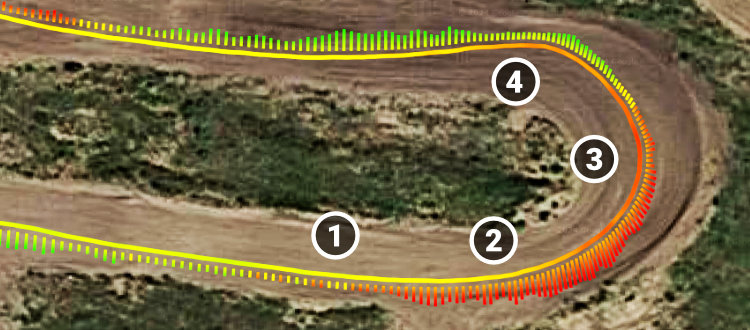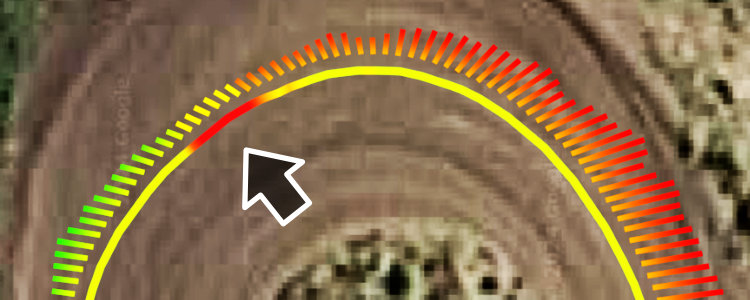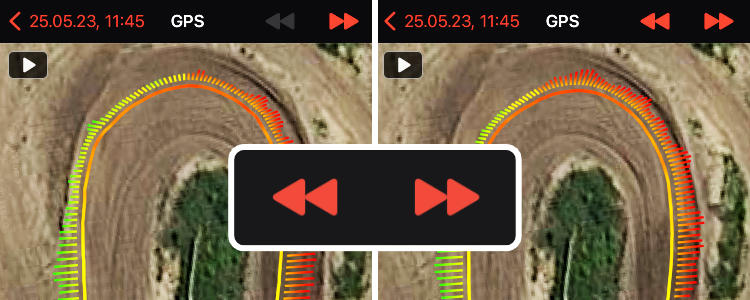Faster Corners
Maximize your cornering skills and boost your technique with acceleration metrics
Metrics
Introducing an exciting enhancement to the MX Buddy experience! The addition of acceleration metrics provides a comprehensive view of throttle control throughout the track, offering valuable insights for refining technique and optimizing performance.
To enable metrics display select the little arrow icon at the top of the GPS analytics view.

And then select the metrics you want to apply.

Please note that metrics can only be activated if you have recorded with a high-frequency GPS sensor (e.g. XGPS160 or RaceBoxMini).
Acceleration & Braking
Acceleration metrics provide detailed insights into how you manage throttle control and maintain speed throughout a lap. Analyzing these metrics can help immensely, especially with cornering.
Color Coding
🟢 Acceleration
🔴 Deceleration
🟡 Low acceleration / Low deceleration
Line Length
Longer lines indicate more acceleration or more braking.
So, now that we know how it works, let's have a look at the 4 basic characteristics of cornering and see how we can use metrics to improve there.

- 1 - Braking Point
- 2 - Entry Speed
- 3 - Mid-Corner Acceleration
- 4 - Exit Speed
1 - Braking Point
Analysis
Review braking metrics to identify where and how much you are braking before entering a corner. Look for consistency and evaluate if braking is occurring too early, too late, or if there are variations between laps.

Improvement
Experiment with braking points and intensity. Gradually adjust your braking technique to find the optimal balance between shedding speed efficiently without sacrificing too much momentum.
2 - Entry Speed
Analysis
Note the speed at which you approach the corner. Make sure that you read off the value at approximately the same point for each lap! Use environmental features on the map to help you.

Improvement
Experiment with different entry speeds to find the sweet spot that allows you to maintain control while carrying sufficient speed into the corner. You can increase this speed over time by working on your riding technique. Proper body position and the right weight on the footpegs are key here!
3 - Mid-Corner Acceleration
Analysis
Evaluate whether you are getting on the throttle smoothly and at the right point. Observe the change in length of the metric lines.
Here is an example

1 - Coming into the corner with a lot of speed and braking hard. Then accelerating smoothly from the apex.
2 - Smooth on the brakes and also smooth through the corner. But a little late on the throttle.
Improvement
Work on refining your mid-corner acceleration. Inconsistent and frequent back-and-forth throttle inputs in a corner will destabilize your bike. Gradually applying throttle will help you to maintain traction and control. Strive to either brake or accelerate. Whether a rolling phase makes sense depends on the shape of the corner and the ground conditions. However, avoid unintentional coasting.
Tip: Select Coast color mode to highlight track segments where you are not accelerating or braking.


4 - Exit Speed
Analysis
Look at the acceleration metrics and note the speed at which you exit the corner. The specific point where you read off the value should be approximately where the lines of all your laps are already pointing straight ahead. Note that if you take a corner on the inside, your bike usually points straight ahead again much later. Use environmental features on the map again for orientation.

Improvement
Experiment with different acceleration points to maximize exit speed. Smooth and controlled acceleration is key to carrying momentum onto the following straight.
Consistency
Analysis
Observe the braking and acceleration patterns (how the metric lines develop during a corner) over several laps. Look for repeating patterns and deviations.
Switch back and forth between the laps to spot the differences.

Improvement
Focus on maintaining a consistent approach to braking and acceleration.
Make this a regular routine in your training sessions. To learn a specific skill and build muscle memory needs repetition. And be patient. Things like this take time.
Summary
Although MX Buddy doesn't replace a riding coach, it does provide deep insights that you can utilize to significantly reduce your lap times!
If you want to learn more about proper cornering technique, go check out the following links.
► AJ Catanzaro | The Moto Academy - Charge Faster Into Corners
► AJ Catanzaro | The Moto Academy - 4 drills to improve your cornering!
► The Mx Factory - How To CORNER Your Dirt Bike!
And also check out these related posts in the MX Buddy blog.